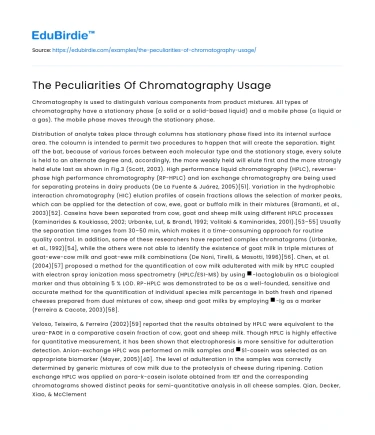Chromatography is used to distinguish various components from product mixtures. All types of chromatography have a stationary phase (a solid or a solid-based liquid) and a mobile phase (a liquid or a gas). The mobile phase moves through the stationary phase.
Distribution of analyte takes place through columns has stationary phase fixed into its internal surface area. The coloumn is intended to permit two procedures to happen that will create the separation. Right off the bat, because of various forces between each molecular type and the stationary stage, every solute is held to an alternate degree and, accordingly, the more weakly held will elute first and the more strongly held elute last as shown in Fig.3 (Scott, 2003). High performance liquid chromatography (HPLC), reverse-phase high performance chromatography (RP-HPLC) and ion exchange chromatography are being used for separating proteins in dairy products (De La Fuente & Juárez, 2005)[51]. Variation in the hydrophobic interaction chromatography (HIC) elution profiles of casein fractions allows the selection of marker peaks, which can be applied for the detection of cow, ewe, goat or buffalo milk in their mixtures (Bramanti, et al., 2003)[52]. Caseins have been separated from cow, goat and sheep milk using different HPLC processes (Kaminarides & Koukiassa, 2002; Urbanke, Luf, & Brandl, 1992; Volitaki & Kaminarides, 2001).[53–55] Usually the separation time ranges from 30–50 min, which makes it a time-consuming approach for routine quality control. In addition, some of these researchers have reported complex chromatograms (Urbanke, et al., 1992)[54], while the others were not able to identify the existence of goat milk in triple mixtures of goat-ewe-cow milk and goat-ewe milk combinations (De Noni, Tirelli, & Masotti, 1996)[56]. Chen, et al. (2004)[57] proposed a method for the quantification of cow milk adulterated with milk by HPLC coupled with electron spray ionization mass spectrometry (HPLC/ESI-MS) by using β-lactoglobulin as a biological marker and thus obtaining 5 % LOD. RP-HPLC was demonstrated to be as a well-founded, sensitive and accurate method for the quantification of individual species milk percentage in both fresh and ripened cheeses prepared from dual mixtures of cow, sheep and goat milks by employing β-lg as a marker (Ferreira & Cacote, 2003)[58].
Save your time!
We can take care of your essay
- Proper editing and formatting
- Free revision, title page, and bibliography
- Flexible prices and money-back guarantee
Veloso, Teixeira, & Ferreira (2002)[59] reported that the results obtained by HPLC were equivalent to the urea-PAGE in a comparative casein fraction of cow, goat and sheep milk. Though HPLC is highly effective for quantitative measurement, it has been shown that electrophoresis is more sensitive for adulteration detection. Anion-exchange HPLC was performed on milk samples and αS1-casein was selected as an appropriate biomarker (Mayer, 2005)[40]. The level of adulteration in the samples was correctly determined by generic mixtures of cow milk due to the proteolysis of cheese during ripening. Cation exchange HPLC was applied on para-k-casein isolate obtained from IEF and the corresponding chromatograms showed distinct peaks for semi-quantitative analysis in all cheese samples. Qian, Decker, Xiao, & McClements (2012)[60] used β-carotene as a marker for the identification of bovine’s milk in ewe or buffalo ricotta cheese which is a naturally component found only in cow milk. Therefore, an easiest and efficient isocratic reversed-phase HPLC method was established for the determination of β-carotene in ricotta cheese and the sensitivity of the assay was claimed to be 0.7 ng and the recovery obtained was more than 90%.
Farag et al. (1984)[61] used gas chromatography for the qualitative and quantitative determination of fatty acids of pure buffalo, bovine and buffalo milk adulterated with bovine milk. By using simple regression equations, adulteration of cow milk in bovine milk was detectable at a minimum level of 5%. Position specific characterisation of triacylglycerol by high resolution gas chromatography (HRGC) combined with simplest chemometric tools (Linear discriminant analysis & Artificial neural network) enabled detection of donkey milk adulterated with cow milk (Cossignani, Blasi, Bos, D'Arco, Maurell, Simonetti, & Damiani, 2011)[62]. Chromatographic and electrophoretic techniques generally depend on the physicochemical properties of mixed native proteins, which might become complex after the proteolysis that occurs during the ripening process due to appearance of intermediate protein and peptide products. Further, if milk is heat-treated then selecting the heat-sensitive protein like whey proteins as the marker proteins could affect the efficiency of the detection method used De La Fuente & Juárez (2005)[51]. Colak, et al. (2006)[63] developed an immuno-chromatographic test kit to detect the presence of cow milk in sheep milk cheese. Recently, advances in application of serially coupled columns or multidimensional chromatography enhanced TAG species resolution (Cossignani, Pollini, & Blasi, 2019)[64].






 Stuck on your essay?
Stuck on your essay?

